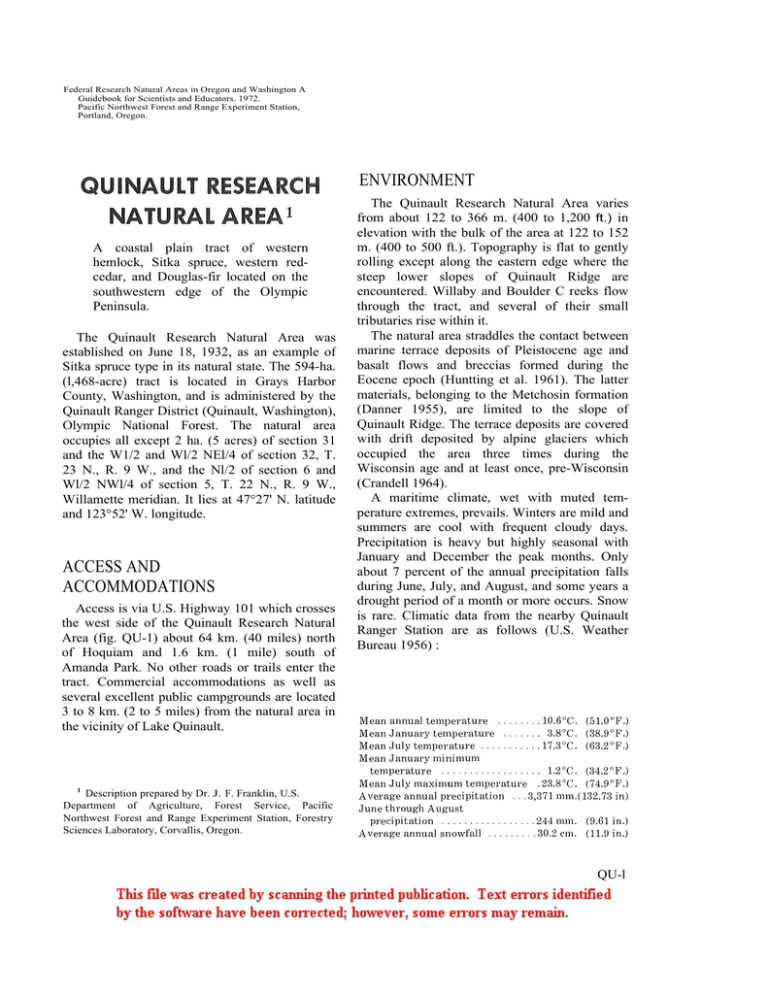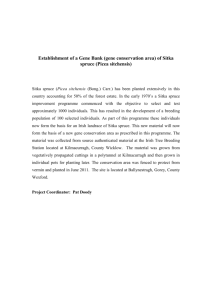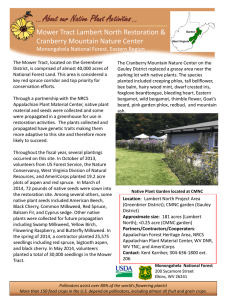Document 11341163
advertisement

Federal Research Natural Areas in Oregon and Washington A Guidebook for Scientists and Educators. 1972. Pacific Northwest Forest and Range Experiment Station, Portland, Oregon. ENVIRONMENT A coastal plain tract of western hemlock, Sitka spruce, western redcedar, and Douglas-fir located on the southwestern edge of the Olympic Peninsula. The Quinault Research Natural Area was established on June 18, 1932, as an example of Sitka spruce type in its natural state. The 594-ha. (l,468-acre) tract is located in Grays Harbor County, Washington, and is administered by the Quinault Ranger District (Quinault, Washington), Olympic National Forest. The natural area occupies all except 2 ha. (5 acres) of section 31 and the W1/2 and Wl/2 NEl/4 of section 32, T. 23 N., R. 9 W., and the Nl/2 of section 6 and Wl/2 NWl/4 of section 5, T. 22 N., R. 9 W., Willamette meridian. It lies at 47°27' N. latitude and 123°52' W. longitude. ACCESS AND ACCOMMODATIONS Access is via U.S. Highway 101 which crosses the west side of the Quinault Research Natural Area (fig. QU-1) about 64 km. (40 miles) north of Hoquiam and 1.6 km. (1 mile) south of Amanda Park. No other roads or trails enter the tract. Commercial accommodations as well as several excellent public campgrounds are located 3 to 8 km. (2 to 5 miles) from the natural area in the vicinity of Lake Quinault. The Quinault Research Natural Area varies from about 122 to 366 m. (400 to 1,200 ft.) in elevation with the bulk of the area at 122 to 152 m. (400 to 500 ft.). Topography is flat to gently rolling except along the eastern edge where the steep lower slopes of Quinault Ridge are encountered. Willaby and Boulder C reeks flow through the tract, and several of their small tributaries rise within it. The natural area straddles the contact between marine terrace deposits of Pleistocene age and basalt flows and breccias formed during the Eocene epoch (Huntting et al. 1961). The latter materials, belonging to the Metchosin formation (Danner 1955), are limited to the slope of Quinault Ridge. The terrace deposits are covered with drift deposited by alpine glaciers which occupied the area three times during the Wisconsin age and at least once, pre-Wisconsin (Crandell 1964). A maritime climate, wet with muted temperature extremes, prevails. Winters are mild and summers are cool with frequent cloudy days. Precipitation is heavy but highly seasonal with January and December the peak months. Only about 7 percent of the annual precipitation falls during June, July, and August, and some years a drought period of a month or more occurs. Snow is rare. Climatic data from the nearby Quinault Ranger Station are as follows (U.S. Weather Bureau 1956) : 1 Description prepared by Dr. J. F. Franklin, U.S. Department of Agriculture, Forest Service, Pacific Northwest Forest and Range Experiment Station, Forestry Sciences Laboratory, Corvallis, Oregon. QU-l The soils on the area have not been mapped or described. They appear relatively deep and loamy with varying amounts of loose rock. At least a portion would probably be classed as Sols Bruns Acides. Soils on gentle topography are underlain by compacted glacial till. BIOTA Estimated areas by SAF cover types (Society of American Foresters 1954) are: The area would probably fall entirely within Kuchler's (1964) Type 1, Spruce-CedarHemlock Forest, and the Picea sitchensis Zone as defined by Franklin and Dyrness (1969). Western hemlock (Tsuga heterophylla), Sitka spruce (Picea sitchensis), Douglas-fir (Pseudotsuga menziesii), and western red-cedar (Thuja plicata) dominate the Quinault Research Natural Area. Although all four species are distributed throughout the area, there tend to be local concentrations (fig. QU -1). Sitka spruce is best represented in the central portion of the natural area but does not occur as a pure stand. Western hemlock is the most abundant species and occurs as a pure or nearly pure type (80 percent by volume) on some of the slopes along the eastern boundary. It also dominates a comparatively young stand along the western boundary . Western red-cedar is most abundant in the northwestern corner of the tract. Douglas-fir dominates a small knoll in the center of the tract and a well-drained area along the northwest boundary. Pacific silver fir (Abies amabilis) is found in small numbers along the lower slopes of Quinault Ridge. The forests on the natural area vary widely in size and age. The oldest and largest diameter trees present are Douglas-fir and QU-2 western red-cedar (fig. QU -2). Approximately 400-year-old Douglas-fir reach heights of almost 90 m. (300 ft.) and diameters of 180 cm. (70 in.) or more at b.h. Sitka spruce and western hemlocks are generally much younger, perhaps 15Q to 200 years in age in the central portion of the natural area. The spruce dominants are in excess of 75 m. (250 ft.) tall and have diameters averaging 90 to 100 cm. (35 to 40 in.) b.h. and, not infrequently, reaching 150 to 180 cm. (60 to 70 in.) b.h. Hemlocks are generally somewhat smaller. The stand of young western hemlock along the western boundary has trees averaging 50- to 60-cm. (20- to 24-in.) d.b.h. Succession in the Quinault Research Natural Area is primarily toward replacement of existing mixed forests by western hemlock. Only western hemlock is consistently represented in all age classes. Seedlings and saplings of hemlock are abundant; some stand openings are completely choked by sapling hemlocks (fig. QU-2). Reproduction of western red-cedar and Douglasfir is almost universally absent. Small Sitka spruce seedlings are common, especially on rotten logs, but they are not so abundant as those of hemlock, and sapling spruce are rarely found under stands. Open, wet depressions dominated by large, old western red-cedar and Sitka spruce provide a possible successional exception; spruce saplings are almost as abundant in these areas as those of hemlock. Along Quinault Ridge, Pacific silver fir is reproducing under closed forests and will apparently be a part of the climax forest. Most tree reproduction is found on rotting logs, "nurse logs," which often support hundreds of hemlock and spruce seedlings (fig. QU-2). Some of these survive and their roots reach mineral soil. The consequences are visible throughout the area as lines of mature trees growing along the remains of the original nurse logs (fig. QU -2). The understory is luxuriant throughout, although relatively poor in species of vascular plants (fig. QU -2). Vaccinium parvifolium, Polystichum munitum, and Oxalis oregana are major dominants. Tiarella trifoliata, Gaultheria shallon, Rubus urslinus, Luzula parvi- flora, Maianthemum bifolium var. kamschaticum, Blechnum spicant, Galium triflorum, and Viola sempervirens are less common. Wet depressions or swampy areas differ considerably. Species there include Rubus spectabilis, vine maple (Acer circinatum), Viola glabella, Trillium ovatum, Cardamine sp., Galium aparine, Rhamnus purshiana, and several Cyperaceae. Since the natural area lies within the so-called "rain forest" region of the western Olympic Peninsula, mosses and liverworts blanket the ground, down logs, shrubs, and tree trunks. Some of the more common ground species are Eurhynchium oreganum, Hypnum circinale, Rhytidiadelphus loreus, Mnium menziesii, Hylocomium splendens, and M. insigne. Among the Pseudisothecium abundant epiphytes are stoloniferum, Porella navicularis, Rhytidiadelphus loreus, Radula bolanderi, Frullania nisqualensis, Scapania bolanderi, and Ptilidium californicum. The Roosevelt elk (Cervis canadensis roosevelti) is the most important animal present. Elk use the natural area as a wintering ground. The relatively open, park-like nature of most of the tract is a consequence of their activity; their trails ease the problems of access through the area. Undoubtedly, they have also affected the composition of the understory vegetation (Sharpe 1956). Other mammals believed to utilize the area as residents or transients are listed in table QU-l. Invertebrates recorded by Shelford (1963) during a visit in 1945 included: millipedes (Harpaphe haydeniana), centipedes (Arctogeophilus melanonotus and Otocryptops sp.), spiders (Hexura picea and Antrodiaetus hageni), numerous brown silverfish, camel crickets (Pristoceuthophilus sp.), (Scaphinotus angusticollis ground beetles velutinus), click beetles (Ctenicera protracta), Sitka bumblebee (Bombus sitkensis), yellow jacket (Vespula arenaria), the lavavorid fly (Ursophyte migriceps), and the boring beetle (Pidonia gnathoides). Streams and streamsides are the specialized habitats which are present. No only lakes, ponds, rock outcrops, etc., exist within the natural area. HISTORY Of DISTURBANCE There is evidence that fires burned over the area 200 or more years ago. Some fire scars can be seen on old western red cedar and Douglas-fir. There is no indication of more recent fires. Human disturbance prior to establishment of the natural area is believed to have had a minor influence on natural conditions. At one time an old pioneer road ran through the area near the base of Quinault Ridge. During World War I the Spruce Production Division built two short skidways into Section 31 and took out a few spruce trees. Finally, some dead cedar was utilized for fence posts. There has been no disturbance since establishment except for that associated with maintenance of U.S. Highway 101. RESEARC H A number of scientists have visited the area in connection with zoologic, geologic, botanic, and paleological studies of the Olympic Peninsula but generally have not published their observations with specific reference to the natural area. One exception is Dr. Victor E. Shelford whose observations on invertebrate fauna (Shelford 1963) were cited earlier. The natural area has been visited as part of two studies currently being made of temperate forest communities on the Olympic Peninsula.2 Special research opportunities which exist on the Quinault Research Natural Area include possibilities for studying (1) the effects of Roosevelt elk on their habitat and (2) the ecology of epiphytic mosses and lichens. MAPS AND AERIAL PHOTOGRAPHS Special maps applicable to the natural 2 Studies by Dr. R. W. Fonda, Biology Department, Western Washington State College, Bellingham, Washington and Mr. Edward Tisch, Biology Department, Peninsula College, Port Angeles, Washington. QU-3 area include: Topography - 15' Quinault Lake, Washington quadrangle, scale 1: 62,500, issued by the U.S. Geological Survey in 1955; and geology - Geologic Map of Washington, scale 1:500,000 (Huntting et al. 1961). Either the District Ranger (Quinault Ranger District) or Forest Supervisor (Olympic National Forest, Olympia, Washington) can provide details on the most recent aerial photo coverage and forest type maps for the area. Records of the 1931 timber inventory and copies of the original forest type and topographic maps, prepared by Forest Service personnel, are on file at the Pacific Northwest Forest and Range Experiment Station, Portland, Oregon. LITERATURE CITED Crandell, Dwight R. 1964. Pleistocene glaciations of the southwestern Olympic Peninsula, Washington. U.S. Geol. Surv. Prof. Pap. 501B:B135-B139, illus. Huntting, Marshall T., W. A. G. Bennett, Vaughan E. Livingston, Jr., and Wayne S. Moen 1961. Geologic map of Washington. Wash. Dep. Conserv., Div. Mines & Geol. Kuchler, A. W. 1964. Manual to accompany the map of potential natural vegetation of the conterminous United States. Am. Geogr. Soc. Spec. Publ. 36, various paging, illus. Sharpe, Grant William 1956. A taxonomical-ecological study of the vegetation by habitats in eight forest types of the Olympic Rain Forest, Olympic National Park, Washington. 335 p., illus. (Ph.D. thesis, on file at Univ. Wash., Seattle.) Shelford, Victor E. 1963. The ecology of North America. 610 p., illus. Urbana: Univ. Ill. Press. Danner, Wilbert R. 1955. Geology of Olympic National Park. 68 p., illus. Seattle: Univ. Wash. Press. Society of American Foresters 1954. Forest cover types of North America (exclusive of Mexico). 67 p., illus. Washington, D.C. Franklin, Jerry F., and C. T. Dyrness 1969. Vegetation of Oregon and Washington. USDA Forest Servo Res. Pap. PNW 80, 216 p., illus. Pac. Northwest Forest & Range Exp. Stn., Portland, Oreg. U.S. Weather Bureau 1956. Climatic summary of the United States supplement for 1931 through 1952, Washington. Climatography of the United States 11-39, 79 p., ill us. QU-4 Figure OU-2.-Communities of the Quinault Research Natural Area. Upper left: Old-growth specimen of western redcedar approximately 150-cm. d.b.h. growing in swampy area. Upper right: Open stand of western hemlock and Sitka spruce about 200 years in age showing dense reproduction of western hemlock. Lower left: Abundant reproduction of western hemlock and other species on typical rotting "nurse" log. Lower right: Mature specimen of Sitka spruce showing the log upon which it originally developed; typical dense understory of Polystichum munitum in the foreground.




